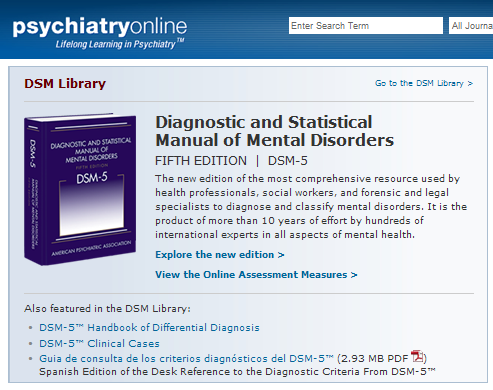
The Spanish edition of the Desk Reference to the Diagnostic Criteria from DSM-5™ (Guia de Consulta de los Criterios Diagnósticos del DSM-5™) is now available as a PDF at the Psychiatry Online DSM Library. This new publication may also be accessed by going directly to the DSM Library collection on PsychiatryOnline, and through the Calder Library Website eDatabases tab. DSM-5 is the latest edition (2013) of the Diagnostic and Statistical Manual of Mental Disorders, used by psychiatrists and psychologists to diagnose patients who suffer from mental illness.
The Spanish Edition of the Desk Reference should be used as a practical guide for Spanish-speakers in conjunction with the English version of DSM-5. Both publications contain the ICD-9-CM and ICD-10-CM Codes for each of the mental disorders. The Spanish Edition has two sections: Section 1 has basic concepts of the DSM-5 and instructions on how to use the manual and Section 2 has the list of all the diagnostic criteria with the codes.
Also in the DSM Library are the DSM-5 Handbook of Differential Diagnosis and DSM-5 Clinical Cases. The DSM-5 Handbook of Differential Diagnosis provides a six-step diagnostic framework, decision trees, and differential diagnosis tables (one for each of the most important DSM-5 disorders) which “should improve clinicians’ skills in formulating a comprehensive differential diagnosis by presenting the problem from a number of different perspectives.” The DSM-5 Clinical Cases book features 103 cases “chosen to demonstrate one or more DSM-5 diagnoses and each of the cases is followed by a short diagnostic discussion.” The cases were based on actual patients. According to the authors, “both books can be used by people outside the mental health field, although both books emphasize that seasoned clinical judgment is often required to differentiate the normal from the pathological in regard to the making of an overall diagnosis, the assessment of specific diagnostic criteria, and the recognition of important comorbidities.” - Quoted from PsychiatryOnline